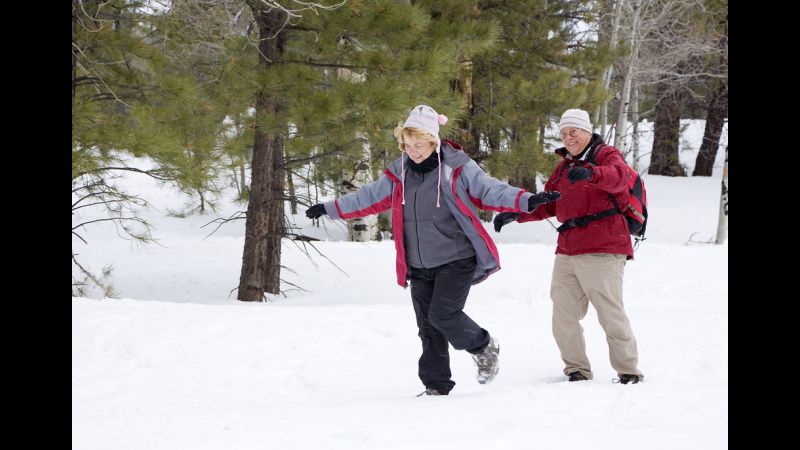When the days get shorter and the temperature gets colder, it can be hard to find the motivation to exercise. Many of us would rather relax in front of the fireplace or T.V. during these long winter months, but exercising regularly year-round is one of the key components of healthy aging.
Although the cold weather brings a few challenges for seniors, it is possible for you to maintain a regular fitness routine and stay active – you just have to consider the following safety precautions first:
Check the weather report.
While there are several outdoor exercises that allow you to enjoy the beautiful winter scenery, such as walking or ice skating, exercising in extreme temperatures is dangerous. Always check the weather report before leaving your home. If it’s very cold or windy out, it’s always best to do indoor workouts instead. Looking at the temperature and wind chill will also help you determine just how much time you should spend outside.
Have your outfit ready.
If the weather forecast shows that the day’s temperature is mild for winter, exercising outdoors won’t harm your health as long as your wardrobe is properly prepared:
- Avoid tight clothing. Not only will tight clothing restrict your movements and increase your risk of falling, but it will also lead to a loss in body heat.
- Wear several layers of loose clothing to protect yourself from the cold. The layers will keep warm air between them.
- Wear a hat, scarf and gloves since most of your body heat is lost from your neck and head.
- Support your feet. Wool or synthetic socks will absorb moisture, and waterproof boots with nonskid soles will help keep you on your feet in slippery conditions.
- Keep sunglasses handy. Wearing sunglasses during the winter may seem odd, but if the sun is shining, any snow on the ground can cause a glare and limit your vision.
Warm up indoors first.
Although it’s often overlooked, warming up with some light stretches like walking or arm pumping before you exercise is essential — no matter how long you plan to exercise for. Not only will this help your body and muscles get ready for your fitness routine, but it will also help prevent accidents and injuries.
And don’t forget about cooling down, too! This will help your heart rate return to normal after you’ve exercised.
Know the symptoms of hypothermia.
No matter how much time you spend outdoors, you need to be on the lookout for the symptoms of hypothermia, especially since seniors are at a greater risk of this condition. Hypothermia occurs when your body’s temperature is below 95 degrees F, causing damage to your nervous system, heart and other central organs.
Since hypothermia is a serious medical emergency that needs to be treated right away, it’s essential that you know the symptoms of hypothermia:
- Shivering
- Dizziness or clumsiness
- Nausea
- Difficulty speaking
- Fatigue
- Shallow breathing
Should you or a loved one notice any of these symptoms, get indoors immediately and call 911.
Indoor Workouts: When Exercising Outdoors Isn’t an Option
Even after following all of these safety precautions, you still may not feel comfortable exercising outside in the cold, and that’s okay! Just remember that you don’t have to let the cold weather keep you from maintaining your fitness routine. There are plenty of indoor workouts you can do to stay physically active regardless of what Mother Nature brings:
- Visit your local gym. Whether you just started a new fitness routine or have been physically active for months, the gym is the perfect place to exercise. Not only can you choose from a variety of machines and weights to find the equipment that’s best suited for you, but you can also find a qualified fitness trainer who will help you reach your goals.
- Sign up for classes. Whether you’re interested in yoga, dancing or swimming, there are countless classes for you to choose from, giving you a chance to learn something new in a safe and supervised setting. As an added bonus, signing up for a class or joining a group is a great way to stay both physically and socially active!
- Use fitness DVDs. With fitness DVDs, you can work up a sweat from the comfort of your own home. Be sure to pick up a few different DVDs featuring a variety of workouts to create a well-rounded fitness routine. This is a great option if the snowy weather ever keeps you from driving to and from the gym.
- Clean the house. Even just by going about your daily routine you can burn calories and stay physically active! It’s easy to view vacuuming and mopping as chores, but you can burn up to 95 calories in just 30 minutes. Cleaning for a full hour burns close to 200 calories. Plus, getting rid of the clutter that tends to accumulate during the wintertime is one of the key steps in preventing elderly falls.

Exercising Safely Year-Round
Whether you’re doing your fitness routine outside, at the gym or in your own home, keep your Mobile Guardian medical alert device nearby so you can call for help should you have an accident while you’re exercising. The emergency operators at Medical Guardian’s monitoring centers work day and night to make sure that you have access to help no matter when you need it.

